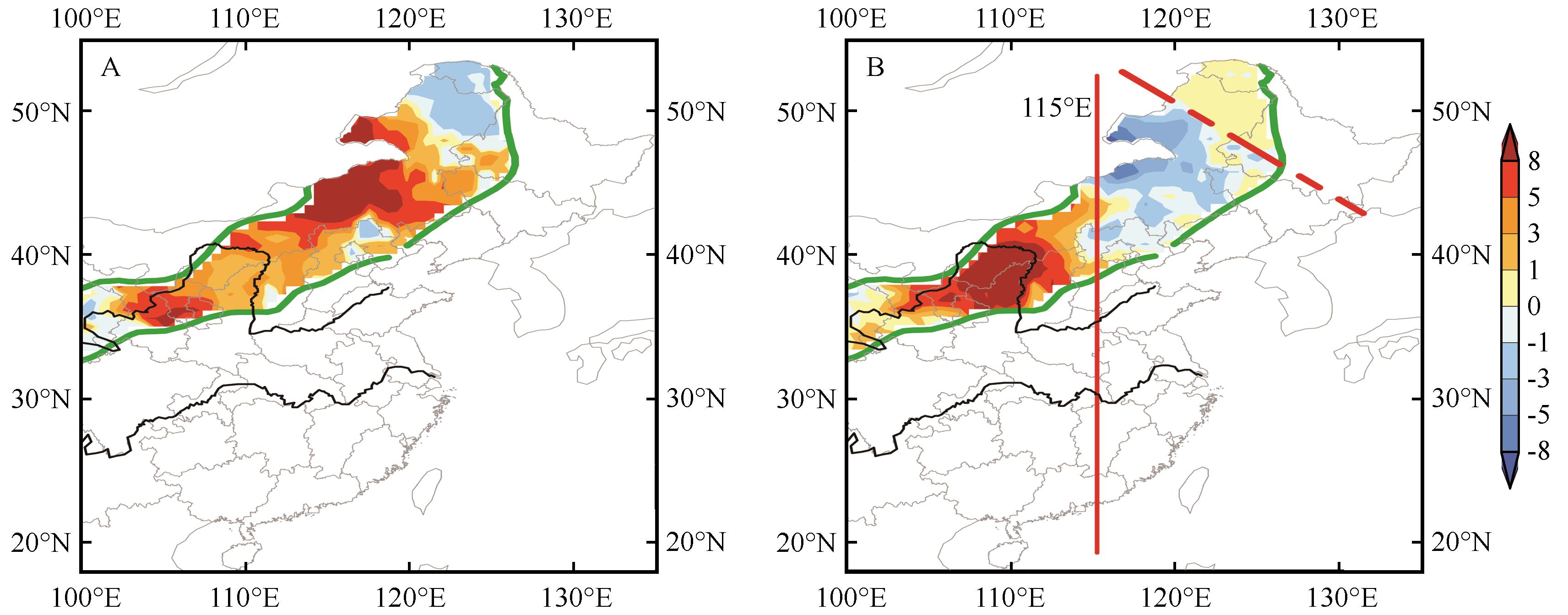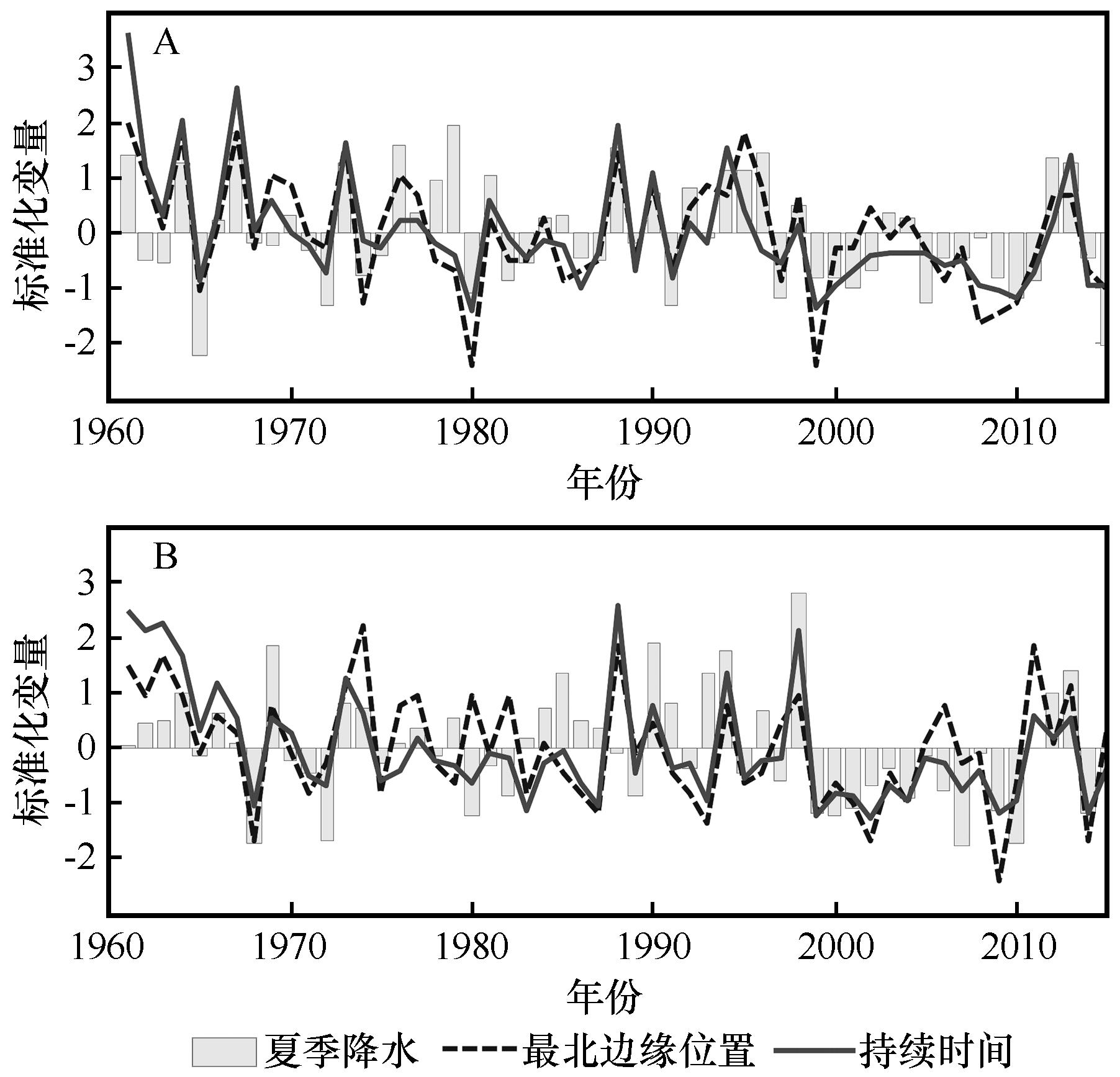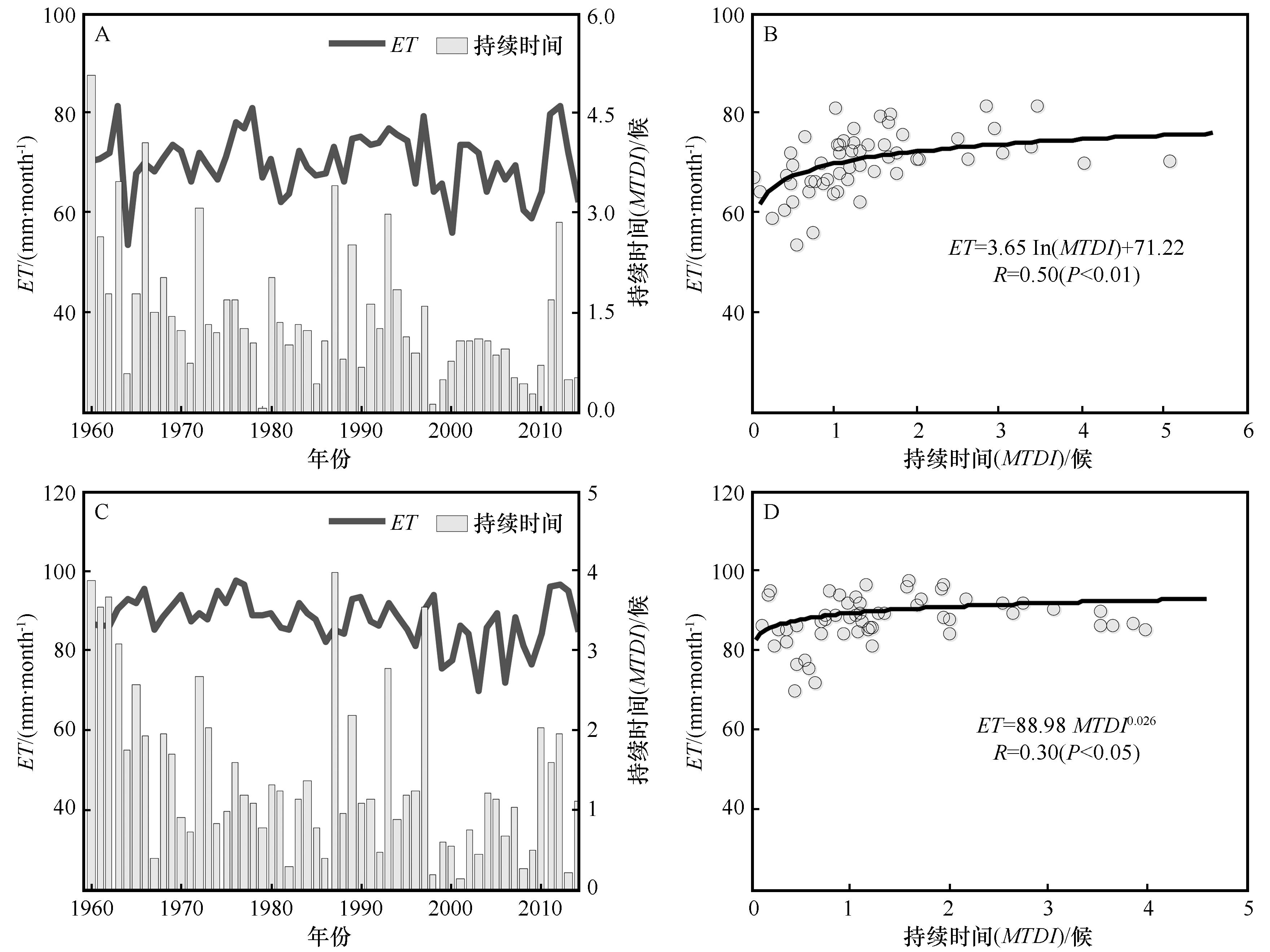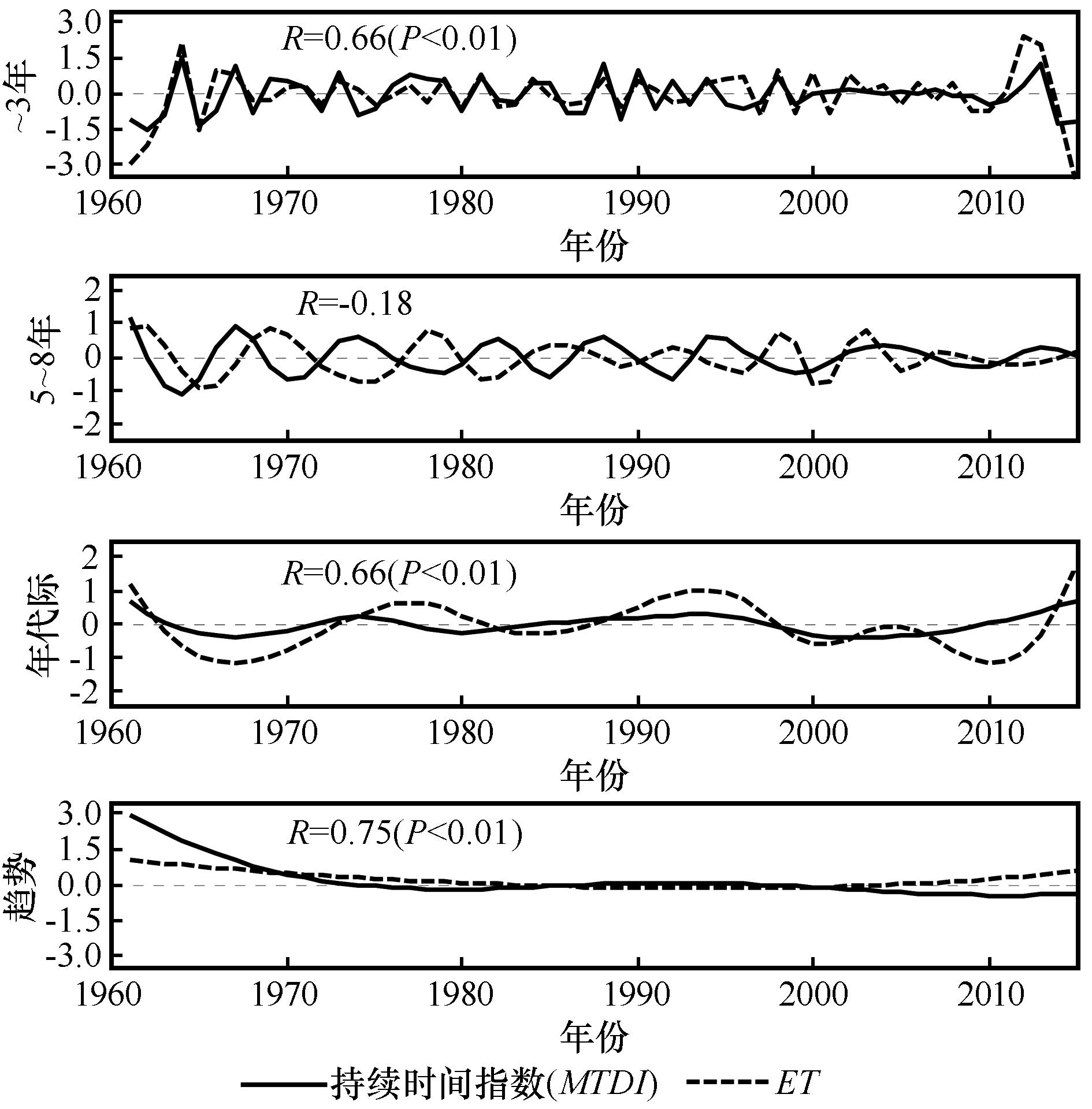
- CN 62-1070/P
- ISSN 1000-694X
- Bimonthly 1981

Journal of Desert Research ›› 2023, Vol. 43 ›› Issue (5): 139-154.DOI: 10.7522/j.issn.1000-694X.2023.00033
Previous Articles Next Articles
Hongyu Li1,2( ), Qiang Zhang2, Ping Yue2, Jian Zeng3(
), Qiang Zhang2, Ping Yue2, Jian Zeng3( ), Xiaonan Guo1
), Xiaonan Guo1
Received:2023-01-11
Revised:2023-04-12
Online:2023-09-20
Published:2023-09-27
Contact:
Jian Zeng
CLC Number:
Hongyu Li, Qiang Zhang, Ping Yue, Jian Zeng, Xiaonan Guo. Response of surface evapotranspiration to the East Asian summer monsoon over the summer monsoon transition zone of China[J]. Journal of Desert Research, 2023, 43(5): 139-154.
Add to citation manager EndNote|Ris|BibTeX
URL: http://www.desert.ac.cn/EN/10.7522/j.issn.1000-694X.2023.00033
| 数据类型 | 名称 | 蒸散发方案/陆面模型 | 空间分辨率 | 时间分辨率 | 时间长度 |
|---|---|---|---|---|---|
| 再分析资料 | NCEP/DOE | OSU LSM | T62 (200 km) | 6 h | 1979—2021年 |
| JRA-55 | SiB | 0.5°×0.5° | 3 h | 1958—2021年 | |
| ERA5 | HTESSEL | 0.25°×0.25° | 1 h | 1959—2021年 | |
| MERRA2 | Catchment LSM | 0.5°×0.625° | 1 h | 1980—2021年 | |
| 离线陆面模式数据集 | GLDAS2.0_NOAH | NOAH | 1°×1° | 3 h | 1958—2014年 |
| 蒸散发遥感产品 | GLEAMv3.6a | 改进的Priestley-Taylor方程 | 0.25°×0.25° | 1 month | 1980—2021年 |
| 陆面观测 | 中国北方陆面过程观测 | 涡动相关方法 | 14个站点 | 30 min | 详见 |
Table 1 Introduction of data used in the study
| 数据类型 | 名称 | 蒸散发方案/陆面模型 | 空间分辨率 | 时间分辨率 | 时间长度 |
|---|---|---|---|---|---|
| 再分析资料 | NCEP/DOE | OSU LSM | T62 (200 km) | 6 h | 1979—2021年 |
| JRA-55 | SiB | 0.5°×0.5° | 3 h | 1958—2021年 | |
| ERA5 | HTESSEL | 0.25°×0.25° | 1 h | 1959—2021年 | |
| MERRA2 | Catchment LSM | 0.5°×0.625° | 1 h | 1980—2021年 | |
| 离线陆面模式数据集 | GLDAS2.0_NOAH | NOAH | 1°×1° | 3 h | 1958—2014年 |
| 蒸散发遥感产品 | GLEAMv3.6a | 改进的Priestley-Taylor方程 | 0.25°×0.25° | 1 month | 1980—2021年 |
| 陆面观测 | 中国北方陆面过程观测 | 涡动相关方法 | 14个站点 | 30 min | 详见 |
| 站点名称 | 纬度 | 经度 | 下垫面类型 | 观测时段 |
|---|---|---|---|---|
| 沙坡头 | 37.45°N | 104.95°E | 荒漠 | 2008年7—9月;2009年7—9月 |
| 张掖 | 38.86°N | 100.41°E | 裸地 | 2008年7—9月;2009年7—9月 |
| 长武 | 35.20°N | 107.67°E | 农田 | 2008年7—9月;2009年7—9月 |
| 锦州 | 41.15°N | 121.20°E | 农田(玉米) | 2008年7—9月;2009年7—9月 |
| 密云 | 40.63°N | 117.32°E | 农田/果林 | 2008年7—9月;2009年7—9月 |
| 平凉 | 35.53°N | 106.94°E | 农田 | 2009年7月至2010年12月 |
| 庆阳 | 35.66°N | 107.84°E | 农田(小麦) | 2009年5月至2010年12月 |
| 馆陶 | 36.52°N | 115.13°E | 农田 | 2009年6—9月 |
| 阿柔 | 38.04°N | 100.46°E | 亚高山草甸 | 2008年7—9月;2009年7—9月 |
| 东苏 | 44.09°N | 113.57°E | 荒漠化草原 | 2008年7—9月;2009年7—9月 |
| 奈曼 | 42.93°N | 120.70°E | 荒漠化草原 | 2008年7—9月;2009年7—9月 |
| 通榆 | 44.88°N | 122.88°E | 退化草原 | 2003年1月至2008年12月 |
| 榆中 | 35.95°N | 104.13°E | 草原 | 2007年1月至2012年12月 |
| 锡林格勒 | 44.13°N | 116.32°E | 草原 | 2004年1月至2008年12月 |
Table 2 Basic information on selected observation sites
| 站点名称 | 纬度 | 经度 | 下垫面类型 | 观测时段 |
|---|---|---|---|---|
| 沙坡头 | 37.45°N | 104.95°E | 荒漠 | 2008年7—9月;2009年7—9月 |
| 张掖 | 38.86°N | 100.41°E | 裸地 | 2008年7—9月;2009年7—9月 |
| 长武 | 35.20°N | 107.67°E | 农田 | 2008年7—9月;2009年7—9月 |
| 锦州 | 41.15°N | 121.20°E | 农田(玉米) | 2008年7—9月;2009年7—9月 |
| 密云 | 40.63°N | 117.32°E | 农田/果林 | 2008年7—9月;2009年7—9月 |
| 平凉 | 35.53°N | 106.94°E | 农田 | 2009年7月至2010年12月 |
| 庆阳 | 35.66°N | 107.84°E | 农田(小麦) | 2009年5月至2010年12月 |
| 馆陶 | 36.52°N | 115.13°E | 农田 | 2009年6—9月 |
| 阿柔 | 38.04°N | 100.46°E | 亚高山草甸 | 2008年7—9月;2009年7—9月 |
| 东苏 | 44.09°N | 113.57°E | 荒漠化草原 | 2008年7—9月;2009年7—9月 |
| 奈曼 | 42.93°N | 120.70°E | 荒漠化草原 | 2008年7—9月;2009年7—9月 |
| 通榆 | 44.88°N | 122.88°E | 退化草原 | 2003年1月至2008年12月 |
| 榆中 | 35.95°N | 104.13°E | 草原 | 2007年1月至2012年12月 |
| 锡林格勒 | 44.13°N | 116.32°E | 草原 | 2004年1月至2008年12月 |
| 下垫面 | 统计指标 | 资料集 | ||||||
|---|---|---|---|---|---|---|---|---|
| NCEP/DOE | JRA-55 | ERA5 | MERRA2 | NOAH | GLEAM | MME | ||
| 草地 | RMSE/(mm·month-1) | 21.69 | 16.63 | 15.01 | 13.60 | 18.71 | 14.29 | 12.97 |
| Bias/(mm·month-1) | 12.34 | 6.88 | -1.23 | -2.79 | -1.32 | -4.94 | 1.49 | |
| R | 0.805 | 0.857 | 0.851 | 0.871 | 0.779 | 0.876 | 0.879 | |
| 农田 | RMSE/(mm·month-1) | 23.42 | 21.96 | 18.90 | 21.48 | 18.43 | 24.19 | 17.61 |
| Bias/(mm·month-1) | 0.45 | 1.40 | 3.98 | -5.35 | -3.29 | -14.97 | -2.96 | |
| R | 0.726 | 0.765 | 0.839 | 0.794 | 0.856 | 0.847 | 0.868 | |
| 所有站点 | RMSE/(mm·month-1) | 22.01 | 17.63 | 16.62 | 15.15 | 18.46 | 16.35 | 13.89 |
| Bias/(mm·month-1) | 10.39 | 5.89 | 0.26 | -3.18 | -1.57 | -6.57 | 0.87 | |
| R | 0.791 | 0.848 | 0.855 | 0.874 | 0.824 | 0.885 | 0.890 | |
Table 3 Error statistics of seven gridded ET dataset
| 下垫面 | 统计指标 | 资料集 | ||||||
|---|---|---|---|---|---|---|---|---|
| NCEP/DOE | JRA-55 | ERA5 | MERRA2 | NOAH | GLEAM | MME | ||
| 草地 | RMSE/(mm·month-1) | 21.69 | 16.63 | 15.01 | 13.60 | 18.71 | 14.29 | 12.97 |
| Bias/(mm·month-1) | 12.34 | 6.88 | -1.23 | -2.79 | -1.32 | -4.94 | 1.49 | |
| R | 0.805 | 0.857 | 0.851 | 0.871 | 0.779 | 0.876 | 0.879 | |
| 农田 | RMSE/(mm·month-1) | 23.42 | 21.96 | 18.90 | 21.48 | 18.43 | 24.19 | 17.61 |
| Bias/(mm·month-1) | 0.45 | 1.40 | 3.98 | -5.35 | -3.29 | -14.97 | -2.96 | |
| R | 0.726 | 0.765 | 0.839 | 0.794 | 0.856 | 0.847 | 0.868 | |
| 所有站点 | RMSE/(mm·month-1) | 22.01 | 17.63 | 16.62 | 15.15 | 18.46 | 16.35 | 13.89 |
| Bias/(mm·month-1) | 10.39 | 5.89 | 0.26 | -3.18 | -1.57 | -6.57 | 0.87 | |
| R | 0.791 | 0.848 | 0.855 | 0.874 | 0.824 | 0.885 | 0.890 | |
| JRA-55 | ERA5 | MERRA2 | NOAH | GLEAM | MME | |
|---|---|---|---|---|---|---|
| NCEP/DOE | 0.719 | 0.676 | 0.869 | 0.549 | 0.617 | 0.889 |
| JRA-55 | 0.77 | 0.688 | 0.747 | 0.835 | 0.900 | |
| ERA5 | 0.513 | 0.68 | 0.587 | 0.788 | ||
| MERRA2 | 0.563 | 0.731 | 0.885 | |||
| NOAH | 0.749 | 0.814 | ||||
| GLEAM | 0.859 |
Table 4 Coefficients of correlation between the gridded datasets for interannual variations in ET averaged over the summer monsoon transition zone (The five highest values in the first five columns are marked in bold)
| JRA-55 | ERA5 | MERRA2 | NOAH | GLEAM | MME | |
|---|---|---|---|---|---|---|
| NCEP/DOE | 0.719 | 0.676 | 0.869 | 0.549 | 0.617 | 0.889 |
| JRA-55 | 0.77 | 0.688 | 0.747 | 0.835 | 0.900 | |
| ERA5 | 0.513 | 0.68 | 0.587 | 0.788 | ||
| MERRA2 | 0.563 | 0.731 | 0.885 | |||
| NOAH | 0.749 | 0.814 | ||||
| GLEAM | 0.859 |

Fig.5 Spatial patterns of the (A) mean and (B) standard deviation (STD) of interannual variations in ET averaged in summer (The area between the two blue lines represents the summer monsoon transition zone)

Fig.6 The first two modes of EOF analysis of ET averaged in summer over the summer monsoon transition zone(The red solid line at 115°E indicates the boundary between the western and eastern parts. The red dashed line represents the boundary between the northern and eastern parts)

Fig.7 Interannual variations of standardized values of summer rainfall, the monsoon northernmost marginal index, and the monsoon temporal duration index (MTDI) over the (A) western and (B) eastern parts of the summer monsoon transition zone

Fig.8 Interannual variations in ET and the monsoon temporal duration index (MTDI) for the (A) western and (C) eastern parts of the summer monsoon transition zone, and scatterplots between ET and the MTDI for the (B) western and (D) eastern parts of the summer monsoon transition zone
| 周期 | 夏季风持续时间(MTDI) | 蒸散发(ET) |
|---|---|---|
| ~3年 | 3.4年(25.4%) | 3.2年(59.7%) |
| 5~8年 | 7.9年(9.8%) | 6.9年(12.6%) |
| 年代际 | 18.0年(3.5%) | 13.8年(14.4%),27.5年(7.6%) |
| 非线性趋势 | (61.3%) | (5.8%) |
Table 5 Mean periods and their variance contributions (in parentheses) of various time scale components of the monsoon temporal duration index (MTDI) and the summer mean ET over the western part of the summer monsoon transition zone obtained from the ensemble empirical mode decomposition method
| 周期 | 夏季风持续时间(MTDI) | 蒸散发(ET) |
|---|---|---|
| ~3年 | 3.4年(25.4%) | 3.2年(59.7%) |
| 5~8年 | 7.9年(9.8%) | 6.9年(12.6%) |
| 年代际 | 18.0年(3.5%) | 13.8年(14.4%),27.5年(7.6%) |
| 非线性趋势 | (61.3%) | (5.8%) |

Fig.9 Decomposition of the monsoon temporal duration index (MTDI) and ET over the western part of the summer monsoon transition zone obtained from the ensemble empirical mode decomposition method
| 1 | 林祥,钱维宏.全球季风和季风边缘研究[J].地球科学进展,2012,27(1):26-34. |
| 2 | 欧廷海,钱维宏.东亚季风边缘带上的植被变化[J].地球物理学报,2006,49(3):698-705. |
| 3 | 符淙斌,马柱国.全球变化与区域干旱化[J].大气科学,2008,32(4):752-760. |
| 4 | Wang K, Dickinson R E.A review of global terrestrial evapotranspiration:observation,modeling,climatology,and climatic variability[J].Reviews of Geophysics,2012,50:RG2005. |
| 5 | Yue P, Zhang Q, Yang Y,et al.Seasonal and inter-annual variability of the bowen ratio over semi-arid grassland in the Chinese Loess Plateau[J].Agricultural & Forest Meteorology,2018,252:99-108. |
| 6 | Huang J, Li Y, Fu C,et al.Dryland climate change: recent progress and challenges[J].Reviews of Geophysics,2017,55:719-778. |
| 7 | Zhang Q, Yang Z S, Hao X C,et al.Conversion features of evapotranspiration responding to climate warming in transitional climate regions in northern China[J].Climate Dynamics,2018,52(7):3891-3903. |
| 8 | Koster R D, Dirmeyer P A, Guo Z C,et al.Regions of strong coupling between soil moisture and precipitation[J].Science,2004,305:1138-1140. |
| 9 | 黄菲,李栋梁,汤绪,等.用过程透雨量确定的东亚夏季风北边缘特征[J].应用气象学报,2009,20(5):530-538. |
| 10 | 胡豪然,钱维宏.东亚夏季风北边缘的确认[J].自然科学进展,2007,17(1):57-65. |
| 11 | Zhang H L, Zhang Q, Yue P,et al.Aridity over a semi-arid zone in Northern China and responses to the East Asian Summer Monsoon[J].Journal of Geophysical Research:Atmospheres,2016,121:13901-13918. |
| 12 | Kanamitsu M, Ebisuzaki W, Woollen J,et al.The NCEP-DOE AMIP-II reanalysis (R2)[J].Bulletin of the American Meteorological Society,2002,83:1631-1643. |
| 13 | Kobayashi S, Ota Y, Harada Y,et al.The JRA-55 Reanalysis: General specifications and basic characteristics[J].Journal of the Meteorological Society of Japan,2015,93:5-48. |
| 14 | Hersbach H, Bell B, Berrisford P,et al.The ERA5 global reanalysis[J].Quarterly Journal of the Royal Meteorological Society,2020,146(730):1999-2049. |
| 15 | Gelaro R, Mccarty W, Suárez M J,et al.The modern-era retrospective analysis for research and applications,version 2 (MERRA-2)[J].Journal of Climate,2017,30:5419-5454. |
| 16 | Rodell M, Houser P R, Jambor U.The global land data assimilation system[J].Bulletin of the American Meteorological Society,2004,85:381-394. |
| 17 | Miralles D G, Holmes T R H, De Jeu R,et al.Global land-surface evaporation estimated from satellite-based observations[J].Hydrology and Earth System Sciences,2011,15:453-469. |
| 18 | Li H, Fu C, Guo W.An integrated evaluation of land surface energy fluxes over China in seven reanalysis/ modeling products[J].Journal Of Geophysical Research-atmospheres,2017,122(16):8543-8566. |
| 19 | 曾剑,张强,王胜.中国北方不同气候区晴天陆面过程区域特征差异[J].大气科学,2011,35(3):483-494. |
| 20 | Zhang Q, Zeng J, Zhang L Y.Characteristics of land surface thermal-hydrologic processes for different regions over North China during prevailing summer monsoon period[J].Science China-Earth Sciences,2012,55(11):1872-1880. |
| 21 | 李宏宇,张强,王春玲,等.基于多源陆面通量数据相融合的新资料及其在中国夏季风影响过渡区的应用[J].大气科学,2020,44(6):1224-1242. |
| 22 | Twine T E, Kustas W P, Norman J M.Correcting eddy-covariance flux underestimates over a grassland[J].Agricultural & Forest Meteorology,2000,103(3):279-300. |
| 23 | Taylor K E.Summarizing multiple aspects of model performance in a single diagram[J].Journal of Geophysical Research Atmospheres,2001,106(D7):7183-7192. |
| 24 | Huang N E, Wu Z H.A review on Hilbert-Huang transform: method and its applications to geophysical studies[J].Reviews of Geophysics,2008,46:RG2006. |
| 25 | Krishnamurti T N, Kishtawal C M, Larow T E,et al.Improved weather and seasonal climate forecasts from multimodel superensemble[J].Science,1999,285:1548-1550. |
| 26 | Lu J, Wang G, Chen T,et al.A harmonized global land evaporation dataset from model-based products covering 1980-2017[J].Earth System Science Data,2021,13:5879-5898. |
| 27 | Pan S F, Pan N Q, Tian H Q,et al.Evaluation of global terrestrial evapotranspiration using state-of-the-art approaches in remote sensing,machine learning and land surface modeling[J].Hydrology and Earth System Sciences,2020,24:1485-1509. |
| 28 | Jiménez C, Prigent C, Mueller B,et al.Global intercomparison of 12 land surface heat flux estimates[J].Journal of Geophysical Research: Atmospheres,2011,116:D02102. |
| 29 | Chen W, Wang L, Feng J,et al.Recent progress in studies of the variabilities and mechanisms of the East Asian Monsoon in a changing climate[J].Advances in Atmospheric Sciences,2019,36(9):887-901. |
| 30 | 张强,岳平,张良,等.夏季风过渡区的陆-气相互作用:述评与展望[J].气象学报,2019,77(4):758-773. |
| 31 | 曾剑,张强,王春玲.东亚夏季风边缘摆动区陆面能量时空分布规律及其与气候环境的关系[J].气象学报,2016,74(6):876-888. |
| 32 | Nemani R R, Keeling C D, Hashimoto H,et al.Climate-driven increases in global terrestrial net primary production from 1982 to 1999[J].Science,2003,300(5625):1560-1563. |
| 33 | Jung M, Reichstein M, Ciais P,et al.Recent decline in the global land evapotranspiration trend due to limited moisture supply[J].Nature,2010,467(7318):951-954. |
| 34 | Li J P, Zeng Q C.A unified monsoon index[J].Geophysical Research Letters,2002,29(8):1274. |
| 35 | Webster P J, Yang S.Monsoon and ENSO:selectively interactive systems[J].Quarterly Journal of the Royal Meteorological Society,1992,118:877-926. |
| 36 | Chen H, Ding Y H, He J H.Reappraisal of Asian summer monsoon indices and the long-term variation of monsoon[J].Acta Meteorologica Sinica,2006,64(6):770-779. |
| 37 | Zeng J, Zhang Q.A humidity index for the summer monsoon transition zone in East Asia[J].Climate Dynamics,2019,53(9):5511-5527. |
| 38 | Belmont A D, Dartt D G.Variation with longitude of the quasi-biennial oscillation[J].Monthly Weather Review,1968,96:767-777. |
| 39 | Li C Y, Pan J, Que Z P.Variation of the East Asian Monsoon and the tropospheric biennial oscillation [J].Chinese Science Bulletin,2011,56:70-75. |
| 40 | Qian C, Zhou T J.Multidecadal variability of North China aridity and its relationship to PDO during 1900-2010[J].Journal of Climate,2014,27(3):1210-1222. |
| 41 | Wu Q Y, Li Q Q, Ding Y H,et al.Asian summer monsoon responses to the change of landsea thermodynamic contrast in a warming climate:CMIP6 projections[J].Advances in Climate Change Research,2022,13(2):205-217. |
| 42 | Yang K, Wu H, Qin J,et al.Recent climate changes over the Tibetan Plateau and their impacts on energy and water cycle:a review [J].Global and Planetary Change,2014,112:79-91. |
| 43 | 周天军,陈梓明,陈晓龙,等.IPCC AR6报告解读:未来的全球气候:基于情景的预估和近期信息[J].气候变化研究进展,2021,17(6): 652-663. |
| [1] | Guangxiang Fu, Qing He, Guosheng Wang, Mingjie Ma, Lulu Yin, Qian Zhang, Wei Tian. Radiation balance characteristics of the ecological transition zone in the southern margin of the Taklamakan Desert [J]. Journal of Desert Research, 2023, 43(5): 116-128. |
| [2] | Qi Zhang, Yonghong Su, Qi Feng, Tengfei Yu, Xiaohong Ma. Estimation of groundwater evapotranspiration of Populus euphratica forest ecosystem along desert river banks based on groundwater level dynamics [J]. Journal of Desert Research, 2022, 42(6): 243-254. |
| [3] | Lin Li, Hu Liu, Chengpeng Sun, Wenzhi Zhao. Groundwater evapotranspiration estimation based on soil moisture and water table measurements [J]. Journal of Desert Research, 2022, 42(6): 277-287. |
| [4] | Honglin Lian, Xueying Han, Yali Liu, Yuqing Han, Wenbin Yang, Wei Xiong. Study on spatiotemporal characteristics of atmospheric drought from 1981 to 2020 in the Mu Us Sandy Land of China based on SPEI index [J]. Journal of Desert Research, 2022, 42(4): 71-80. |
| [5] | Dagang Wang, Yang Yu, Lingxiao Sun, Jing He, Malik Ireneusz, Wistuba Malgorzata, Fengqing Jiang, Ruide Yu. Adaptability evaluation and modification of ET0 models in a typical oases on southern margin of the Taklimakan Desert [J]. Journal of Desert Research, 2021, 41(6): 41-53. |
| [6] | Wei Gong, Guanglu Hu, Pengcheng Fu, Haoran Li, Chuan Zhou, Liyuan Deng. Soil moisture infiltration characteristics of different sand-fixing plants in the desert-oasis transition zone in arid region of China [J]. Journal of Desert Research, 2020, 40(5): 200-208. |
| [7] | Sasa Zhou, Qing He, Lili Jin, Jiantao Zhang. Radiation characteristics of the oasis-desert transition zone in the northern margin of the Taklimakan Desert: a case study of Xiaotang [J]. Journal of Desert Research, 2020, 40(4): 43-51. |
| [8] | Li Xia, Liu Tingxi, Duan Limin, Wang Guanli, Tong Xin, Zhou Yajun, Yang Xiaojun. Simulation of reference crop evapotranspiration and analysis of the factor effect in Horqin wet meadow [J]. Journal of Desert Research, 2020, 40(2): 134-143. |
| [9] | Jin Lili, Li Zhenjie, He Qing, Ali Mamtimin, Huo Wen, Zhang Jiantao. Characteristic of Surface-Layer Turbulence Spectra on Typical Sunny Days over the Northern Marginal Zone of the Taklimakan Desert [J]. Journal of Desert Research, 2019, 39(6): 1-12. |
| [10] | Qi Xiujiao, Liu Tingxi, Duan Limin, Chen Xiaoping, Huang Tianyu. Transpiration and Evapotranspiration of Caragana microphylla Community Measured with the Sap Flow and Eddy Covariance Methods [J]. Journal of Desert Research, 2019, 39(4): 73-82. |
| [11] | Bao Yongzhi, Duan Limin, Liu Tingxi, Wang Guanli, Tong Xin. Simulation of Evapotranspiration of Caragana microphylla Community [J]. Journal of Desert Research, 2019, 39(4): 177-186. |
| [12] | Meng Yangyang, Liu Bing, Liu Chan. Dynamic Process of Water-Heat-Salt in Soil and the Mechanism in the Desert Oasis Wetland [J]. Journal of Desert Research, 2019, 39(1): 149-160. |
| [13] | Qi Xiaofan, Li Wenpeng, Li Haitao. Prediction and Trend of Future Potential Evapotranspiration in the Heihe River Basin Based on CMIP5 Models [J]. Journal of Desert Research, 2018, 38(4): 849-857. |
| [14] | Fan Yayun, Guo Yuchuan, Lu Gang, Chen Lihua, Zhang Xiaoyu, He Xuemin, Yang Jianjun. Vegetation Ecological Water Requirement of Ebinur Lake Watershed [J]. Journal of Desert Research, 2018, 38(4): 865-871. |
| [15] | Huang Yuxia, Wang Baojian, Wang Yanfeng, Huang Wubin, Wang Lin. Variation of East Asian Summer Monsoon and Its Influences on Summer Rainstorm Days in Gansu, China [J]. JOURNAL OF DESERT RESEARCH, 2017, 37(1): 140-147. |
| Viewed | ||||||
|
Full text |
|
|||||
|
Abstract |
|
|||||
©2018Journal of Desert Research
Tel:0931-8267545
Email:caiedit@lzb.ac.cn;desert@lzb.ac.cn
Support:Magtech